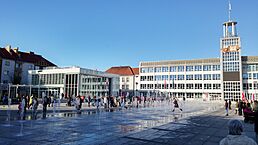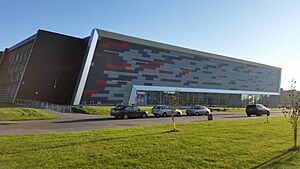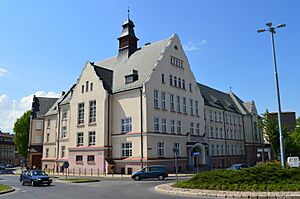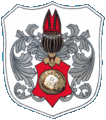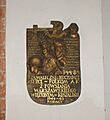Koszalin facts for kids
Quick facts for kids
Koszalin
|
|||
|---|---|---|---|
|
|||
|
|||
| Motto(s):
Center of Pomerania (Polish: Centrum Pomorza)
|
|||
| Country | |||
| Voivodeship | |||
| County | city county | ||
| Established | 11th century | ||
| Town rights | 1266 | ||
| Area | |||
| • Total | 115.5 km2 (44.6 sq mi) | ||
| Elevation | 32 m (105 ft) | ||
| Population
(31 December 2021)
|
|||
| • Total | 104,994 |
||
| Time zone | UTC+1 (CET) | ||
| • Summer (DST) | UTC+2 (CEST) | ||
| Postal code |
75-900, 75-902, 75-007, 75-016
|
||
| Area code(s) | +48 94 | ||
| Vehicle registration | ZK | ||
| Climate | Cfb | ||
| Highways | |||
Koszalin is a city in northwestern Poland. It is part of Western Pomerania, a historical region. The city is about 12 kilometers (7.5 miles) south of the Baltic Sea coast. The Dzierżęcinka river flows through Koszalin.
Koszalin is an important city in the West Pomeranian Voivodeship. It serves as a county-status city and is the capital of Koszalin County.
Contents
History of Koszalin
People have lived in the area of Koszalin since ancient times. Archaeologists have found signs of early human settlements. These include traces from the Funnelbeaker, Globular Amphora, and Lusatian cultures. There are also findings from ancient Roman times and the Early Middle Ages.
Early Beginnings and Polish Rule
The land around Koszalin became part of the new Polish state around the year 967. This was under the rule of Mieszko I, Poland's first known ruler. An old Polish book, the Chronicle of Greater Poland, says that Duke Bolesław III Wrymouth of Poland took control of Koszalin in 1107.
Later, in the 12th century, the area became part of the Duchy of Pomerania. This duchy was a smaller state that was connected to Poland. It later became a vassal state of Denmark and then part of the Holy Roman Empire.
Becoming a Town
In 1214, Duke Bogislaw II gave a village called Koszalice to a monastery. New settlers, many from Germany, were invited to live in the area. In 1248, the village was given to the Roman Catholic Diocese of Kammin.
On May 23, 1266, Bishop Hermann von Gleichen officially made Koszalice a town. He gave it special rights, known as Lübeck law. These rights gave the town local government and many benefits to attract more settlers. In 1278, a Cistercian monastery was built. It took care of the local church and a chapel on Chełmska Hill.
The city gained access to the Baltic Sea in 1331 by getting the village of Jamno. It also got parts of Lake Jamno and a castle. This allowed Koszalin to join the Hanseatic League in 1386. The Hanseatic League was a powerful group of trading cities around the Baltic Sea. This led to some fights with nearby port cities like Kołobrzeg.
From 1356 to 1422, Koszalin was part of the Duchy of Pomerania-Wolgast. In 1446, Koszalin won a battle against its rival city, Kołobrzeg. In 1475, there was a conflict between the city and Duke Bogislaw X. The duke was even kidnapped and held in Koszalin for a short time.
Changes in Modern Times
Over time, more German settlers arrived, and the city became mostly German-speaking. In 1516, local Germans made a rule against buying goods from Slavic speakers. They also made it hard for native Slavs to join craft guilds. This shows there was ethnic discrimination.
In 1531, there were arguments about the Protestant Reformation. By 1534, Koszalin became mostly Lutheran. In 1568, Duke John Frederick, Duke of Pomerania started building a residence in the city.
After the last Pomeranian duke died in 1637, the city was taken by Swedish troops during the Thirty Years' War. Some people from Koszalin went to Poland for safety. In 1648, after the war, the city became part of Brandenburg-Prussia. It was then called Cöslin.
The city was badly damaged by a fire in 1718 but was rebuilt. In 1764, a Pole named Jan Gelczewski started a paper mill on Chełmska Hill. In 1807, French troops occupied the city.
After the Napoleonic wars, Cöslin became an important regional capital in Prussia. A road connecting Cöslin with Szczecin and Gdańsk was built between 1829 and 1845. A part of this road was built in 1833 by about a hundred former Polish insurgents. These were Poles who had fought against Russian rule. In 1869, Polish people in the city built the Saint Joseph church.
In 1871, the town became part of the German Empire. A railway line was built through Cöslin from 1858 to 1878. A military school was moved to the city in 1890.
World War II and After
When the Nazi Party came to power in Germany in 1933, they set up a secret police (Gestapo) office in the city. Many people who opposed the Nazis were arrested. During Second World War, Koszalin was a site for training rocket troops.
The Polish resistance worked in the city. They gathered information about German activities and shared secret Polish newspapers. The Nazis forced many people to work in the city, mostly Poles, but also Italians and French. There were several forced labor camps in Koszalin. Polish forced laborers made up a large part of the city's population during the war. After the Warsaw Uprising, many Poles, especially women and children, were brought to Koszalin by the Germans.
On March 4, 1945, the Red Army captured the city. After the war, under the Potsdam Agreement, Koszalin became part of Poland again. The German people who lived there were moved to other parts of Germany. Poles and Kashubians from other parts of Poland, especially those who had been forced to leave their homes by the Soviets, settled in Koszalin.
Life in the city began to rebuild in May 1945. Schools, shops, and services were set up. In 1946, the first public library opened. In July 1947, the last Soviet troops left Koszalin. In 1953, a local radio station was started.
Koszalin was an important regional capital in post-war Poland. From 1950 to 1975, it was the capital of a larger region called Koszalin Voivodeship. It became one of the fastest-growing cities in Poland. In 1991, Pope John Paul II visited Koszalin. A monument to him was later put up in the city center.
Landmarks in Koszalin
The city is next to Chełmska Hill (Góra Chełmska). This hill was a place of worship in ancient times. Today, it has a "sanctuary of the covenant" tower, which was blessed by Pope John Paul II in 1991. It is now a place where people go on pilgrimages. There is also an observation tower on the hill. At the entrance to the sanctuary, there is a monument to Polish insurgents from 1831. These brave Poles, who were imprisoned by Prussian authorities, helped build a road connecting Koszalin with nearby Sianów.
Koszalin's most famous building is the Gothic St. Mary's Cathedral. It was built in the early 14th century. In front of the cathedral, there is a monument remembering Pope John Paul II's visit.
Other important places in the city include the Park of the Dukes of Pomerania (Park Książąt Pomorskich), the Koszalin Museum, and the main post office. There is also the 16th-century Wedding Palace and the Culture Centre 105.
The city also has statues honoring Polish national heroes. These include Józef Piłsudski, Władysław Anders, Kazimierz Pułaski, and Władysław Sikorski. There are also monuments to 19th-century Polish poets Cyprian Norwid and Adam Mickiewicz.
Climate
Koszalin has an oceanic climate. This means it has mild temperatures all year round. It is near the Baltic Sea, which helps keep the weather moderate. Summers are warm but usually not too hot. Winters are cold but often milder than in eastern Poland.
The average temperature in January and February is just above freezing. In summer, the average temperature is around 15 to 16 degrees Celsius (59-61°F). The city gets about 704 millimeters (27.7 inches) of rain each year. Koszalin is also known as one of the sunniest cities in Poland.
| Climate data for Koszalin (Wilkowo), elevation: 33 m, 1991–2020 normals, extremes 1951–present | |||||||||||||
|---|---|---|---|---|---|---|---|---|---|---|---|---|---|
| Month | Jan | Feb | Mar | Apr | May | Jun | Jul | Aug | Sep | Oct | Nov | Dec | Year |
| Record high °C (°F) | 13.2 (55.8) |
17.7 (63.9) |
23.3 (73.9) |
28.2 (82.8) |
31.2 (88.2) |
35.6 (96.1) |
36.4 (97.5) |
37.1 (98.8) |
33.9 (93.0) |
27.3 (81.1) |
18.8 (65.8) |
13.6 (56.5) |
37.1 (98.8) |
| Mean maximum °C (°F) | 8.9 (48.0) |
10.0 (50.0) |
16.1 (61.0) |
22.8 (73.0) |
26.9 (80.4) |
29.4 (84.9) |
30.4 (86.7) |
30.3 (86.5) |
24.9 (76.8) |
19.4 (66.9) |
13.2 (55.8) |
9.6 (49.3) |
32.5 (90.5) |
| Mean daily maximum °C (°F) | 2.5 (36.5) |
3.5 (38.3) |
7.0 (44.6) |
12.8 (55.0) |
17.1 (62.8) |
20.1 (68.2) |
22.4 (72.3) |
22.5 (72.5) |
18.2 (64.8) |
12.7 (54.9) |
7.1 (44.8) |
3.5 (38.3) |
12.5 (54.5) |
| Daily mean °C (°F) | 0.3 (32.5) |
0.9 (33.6) |
3.3 (37.9) |
8.0 (46.4) |
12.3 (54.1) |
15.6 (60.1) |
17.9 (64.2) |
17.9 (64.2) |
14.0 (57.2) |
9.3 (48.7) |
4.8 (40.6) |
1.6 (34.9) |
8.8 (47.8) |
| Mean daily minimum °C (°F) | −1.9 (28.6) |
−1.6 (29.1) |
0.2 (32.4) |
3.8 (38.8) |
7.8 (46.0) |
11.3 (52.3) |
13.7 (56.7) |
13.8 (56.8) |
10.4 (50.7) |
6.4 (43.5) |
2.6 (36.7) |
−0.6 (30.9) |
5.5 (41.9) |
| Mean minimum °C (°F) | −11.4 (11.5) |
−9.6 (14.7) |
−6.5 (20.3) |
−2.3 (27.9) |
0.9 (33.6) |
5.7 (42.3) |
9.1 (48.4) |
8.5 (47.3) |
4.4 (39.9) |
0.0 (32.0) |
−3.6 (25.5) |
−8.1 (17.4) |
−14.4 (6.1) |
| Record low °C (°F) | −26.7 (−16.1) |
−26.7 (−16.1) |
−18.7 (−1.7) |
−10.1 (13.8) |
−3.9 (25.0) |
−0.6 (30.9) |
2.6 (36.7) |
2.3 (36.1) |
−0.2 (31.6) |
−6.1 (21.0) |
−14.0 (6.8) |
−19.7 (−3.5) |
−26.7 (−16.1) |
| Average precipitation mm (inches) | 52.4 (2.06) |
40.1 (1.58) |
46.0 (1.81) |
33.8 (1.33) |
54.3 (2.14) |
76.4 (3.01) |
90.2 (3.55) |
88.8 (3.50) |
74.7 (2.94) |
66.0 (2.60) |
56.1 (2.21) |
59.2 (2.33) |
738.2 (29.06) |
| Average extreme snow depth cm (inches) | 5.1 (2.0) |
5.5 (2.2) |
3.4 (1.3) |
0.3 (0.1) |
0.0 (0.0) |
0.0 (0.0) |
0.0 (0.0) |
0.0 (0.0) |
0.0 (0.0) |
0.4 (0.2) |
1.4 (0.6) |
3.8 (1.5) |
5.5 (2.2) |
| Average precipitation days (≥ 0.1 mm) | 17.37 | 15.74 | 13.57 | 11.23 | 13.10 | 13.17 | 14.57 | 14.60 | 13.90 | 16.13 | 16.30 | 18.77 | 178.44 |
| Average snowy days (≥ 0 cm) | 11.1 | 10.8 | 5.3 | 0.3 | 0.0 | 0.0 | 0.0 | 0.0 | 0.0 | 0.2 | 2.0 | 7.2 | 36.9 |
| Average relative humidity (%) | 85.7 | 83.4 | 78.9 | 72.8 | 74.2 | 76.3 | 77.4 | 77.1 | 80.4 | 83.7 | 87.5 | 87.9 | 80.5 |
| Average dew point °C (°F) | −3 (27) |
−2 (28) |
0 (32) |
3 (37) |
7 (45) |
11 (52) |
14 (57) |
13 (55) |
10 (50) |
6 (43) |
4 (39) |
0 (32) |
5 (41) |
| Mean monthly sunshine hours | 44.7 | 67.8 | 132.2 | 203.4 | 262.7 | 256.8 | 259.2 | 233.2 | 166.5 | 111.1 | 50.6 | 32.4 | 1,820.6 |
| Source 1: Institute of Meteorology and Water Management | |||||||||||||
| Source 2: Meteomodel.pl (records, relative humidity 1991–2020), Time and Date (dewpoints, 2005-2015) | |||||||||||||
Sports in Koszalin
Koszalin has several sports teams:
- AZS Koszalin - This is the men's basketball team. They play in the top Polish basketball league.
- AZS Politechnika Koszalin - This is the women's handball team. They play in the Polish Ekstraklasa Women's Handball League.
- Gwardia Koszalin - This is a football (soccer) team. They play in the fourth Polish division.
- Bałtyk Koszalin - Another football team, also playing in the fourth Polish division.
- There are also teams for tennis, rugby, motorsport, and American football.
Film Festival
Koszalin hosts an annual film festival called the Koszalin Festival of Film Debuts "The Youth and Film". It has been held since 1973. The main goal of the festival is to support and promote young filmmakers.
Since 2007, the festival has been a competition for new Polish films. This includes feature films, short films, documentaries, and animations. Besides the competition, there are also special screenings, workshops, and discussions about new cinema. It is the oldest festival for young cinema in Poland. Famous filmmakers like Krzysztof Zanussi and Krzysztof Kieślowski debuted their films here.
Education in Koszalin
Koszalin has many schools and universities:
- Koszalin University of Technology (Politechnika Koszalińska)
- Baltic College (Bałtycka Wyższa Szkoła Humanistyczna)
- Air Force training center (Centrum Szkolenia Sił Powietrznych im. Romualda Traugutta)
- Koszalin University of Humanities (Koszalińska Wyższa Szkoła Nauk Humanistycznych)
- State Higher Vocational School in Koszalin (Państwowa Wyższa Szkoła Zawodowa w Koszalinie)
- Major Seminary of the Diocese of Koszalin-Kolobrzeska in Koszalin (Wyższe Seminarium Duchowne Diecezji Koszalińsko-Kołobrzeskiej w Koszalinie)
- Team State School of Music (Zespół Państwowych Szkół Muzycznych im. Grażyny Bacewicz)
- School Arts Team (Zespół Szkół Plastycznych im. Władysława Hasiora)
- Several high schools, including Stanisława Dubois High School and Władysława Broniewskiego High School.
Notable People from Koszalin
- Rudolf Clausius (1822–1888), a famous physicist and mathematician. He helped create the science of thermodynamics.
- Paul Dahlke (1904–1984), a well-known actor in plays and movies.
- Leslie Brent (1925–2019), an immunologist and zoologist.
- Mirosław Okoński (born 1958), a footballer who played many professional games and for the Polish national team.
- Kuba Wojewódzki (born 1963), a popular journalist, TV personality, and comedian.
- Sebastian Mila (born 1982), a Polish professional footballer.
- Daria Zawiałow (born 1992), a talented singer-songwriter.
- Kacper Kozłowski (born 2003), a young Polish professional footballer.
Twin Towns – Sister Cities
Koszalin has "twin town" or "sister city" relationships with many cities around the world. This means they share cultural and educational ties.
 Albano Laziale, Italy
Albano Laziale, Italy Bourges, France
Bourges, France Fuzhou, China
Fuzhou, China Gladsaxe, Denmark
Gladsaxe, Denmark Ivano-Frankivsk, Ukraine
Ivano-Frankivsk, Ukraine Kristianstad, Sweden
Kristianstad, Sweden Lida, Belarus
Lida, Belarus Neubrandenburg, Germany
Neubrandenburg, Germany Neumünster, Germany
Neumünster, Germany Schwedt, Germany
Schwedt, Germany Seinäjoki, Finland
Seinäjoki, Finland Tempelhof-Schöneberg (Berlin), Germany
Tempelhof-Schöneberg (Berlin), Germany Trakai, Lithuania
Trakai, Lithuania
Images for kids
-
The Victory Square with the statue of Józef Piłsudski
-
Memorial stone dedicated to Kazimierz Pułaski in the Amphitheater Park
See also
 In Spanish: Koszalin para niños
In Spanish: Koszalin para niños


